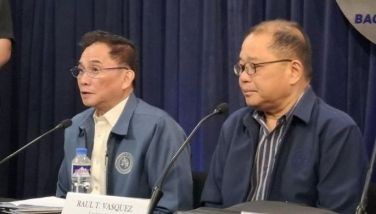JBC composition, rules need some reviewing

The PNP-Southern Tagalog merits praise. In only two days it solved the robbery killing of Nixon Kua, ex-bureaucrat and our fellow-columnist in the STAR group. All four identified attackers were arrested Monday night, thanks to sharp detective work.
Sadly Nixon expired in the hospital also Monday. The gunshot wound in the face was grave; the slug had exited through the nape.
* * *
Around this time two years ago Osmeña Service Road in Bangkal, Makati, looked like a battle zone. Road barriers and yellow Do-Not-Cross cordons ringed the area. Police cars, ambulances and fire trucks stood by for action. Outsiders’ vehicles and pedestrians were forbidden approach. Residents of the 22-story West Tower Condos had been evacuated. A segment of the 117-kilometer-long pipeline owned by First Philippine Industrial Corp. (FPIC) was found to be leaking oil into the basement.
Last June the road reopened to all traffic. No more “Danger” notices, emergency vehicles, and jams that inconvenienced motorists for two years. Cleaners report no odor of gas fumes. Drinking water samples taken at the site have been normal. Passersby would be spotted indiscriminately (and unfortunately) throwing cigarette butts.
The Department of Energy has filed a manifestation before the Court of Appeals stating that the pipeline is safe to re-operate. Tests conducted last December indicated no more leak.
Osmeña Service Road runs parallel to the Magallanes Interchange and South Luzon Expressway where thousands of vehicles pass through. Bangkal-Makati has four public elementary schools, one high school, two kindergartens, and a daycare.
Now under the Magallanes Interchange is a contraption as big as a classroom. The FPIC uses it to siphon off the residual gasoline in the soil and groundwater. It is said to be the only one of its kind in the country. College students and curious plain folk reportedly have checked it out. An FPIC environmental remediation engineer explains how it works. More than a million liters of leaked gasoline have been recovered.
FPIC also has an office in an old house along Capinpin Street, in the heart of Barangay Bangkal. Open to the public as well, it is manned by an FPIC community-relations officer who explains what has been and is being done after the oil leak.
A group of West Tower condo owners, however, point to this very remediation as proof that the building is still uninhabitable. They want FPIC to recompense them with condos of similar price and proximity, and so contest the government reports. For them, the absence of noxious fumes does not mean they are safe from harm.
The court will have to decide which scientific evidence is stronger of the contenders.
* * *
The Judicial and Bar Council began yesterday to remake the Chief Justiceship. It had helped damage the position by allowing the midnight appointment of the last CJ in 2010. Consequently the CJ was impeached for hidden wealth and open bias. Televising for the first time its interviews of CJ aspirants was the JBC’s response to cries for lucidity in the vetting. Yet for the same end of clarity, the JBC must review its own makeup and rules.
Makeup involves representation of the three government branches. The Constitution designates the Chief Justice as ex officio chairman, and the Secretary of Justice and a delegate of Congress as ex officio members. It gives the Judiciary, Executive and Legislative one representative each. In addition are reps from the Integrated Bar, law academe, retired justices, and public sector, as regular members.
Last week the Supreme Court ruled that the chairmen of the Senate and House committees on justice may no longer sit simultaneously in the JBC. Only one senator or congressman may sit, in keeping with the spirit and letter of the fundamental law. Actually it used to be either of the two chairmen, upon the revival of Congress under the 1987 Constitution. Then, the JBC allowed both to sit at the same time, though with only half vote each. Later it let simultaneous participation, each with full votes.
The matter of makeup involves also the reps of the Judiciary and the Executive, especially in a situation like the present. Upon the sacking of CJ Renato Corona last May, the most senior SC associate, Antonio Carpio, became acting CJ. But because he accepted automatic nomination to CJ, Carpio had to inhibit himself from JBC deliberations. Justice Sec. Leila de Lima too accepted nomination and inhibited from the JBC.
The SC then designated Justice Diosdado Peralta as JBC presiding officer in lieu of Carpio. This was within the JBC rules that the SC had approved. But then, is such rule in consonance with the Constitution, which names the CJ, not any alternate, as ex officio chairman? May not an alternate presiding officer from the SC be partial to any or all sitting SC justices, in the present case five, nominated for CJ? (To insulate from politicking, I personally am for the appointment of a senior justice to be CJ, but not by stacking the odds.)
Malacañang too named an alternate JBC rep for the recused de Lima. President Noynoy Aquino put in Atty. Michael Musngi, an undersecretary of the Office of Special Affairs. Does this not give the President a say in the vetting of the candidates? Will not the body language of the alternate signal to the other JBC members who Aquino wants, among the 26 candidates, to be inserted in the short list?
Also begging restudy is the JBC rule that automatically disqualifies a CJ or SC nominee who is facing a disbarment case before the Integrated Bar. The rule could tempt a nominee to cut a deal with the adjudicators: clear me now, and I will favor your cases once I join the SC.
* * *
Catch Sapol radio show, Saturdays, 8-10 a.m., DWIZ (882-AM).
* * *
E-mail: [email protected]
- Latest
- Trending






























